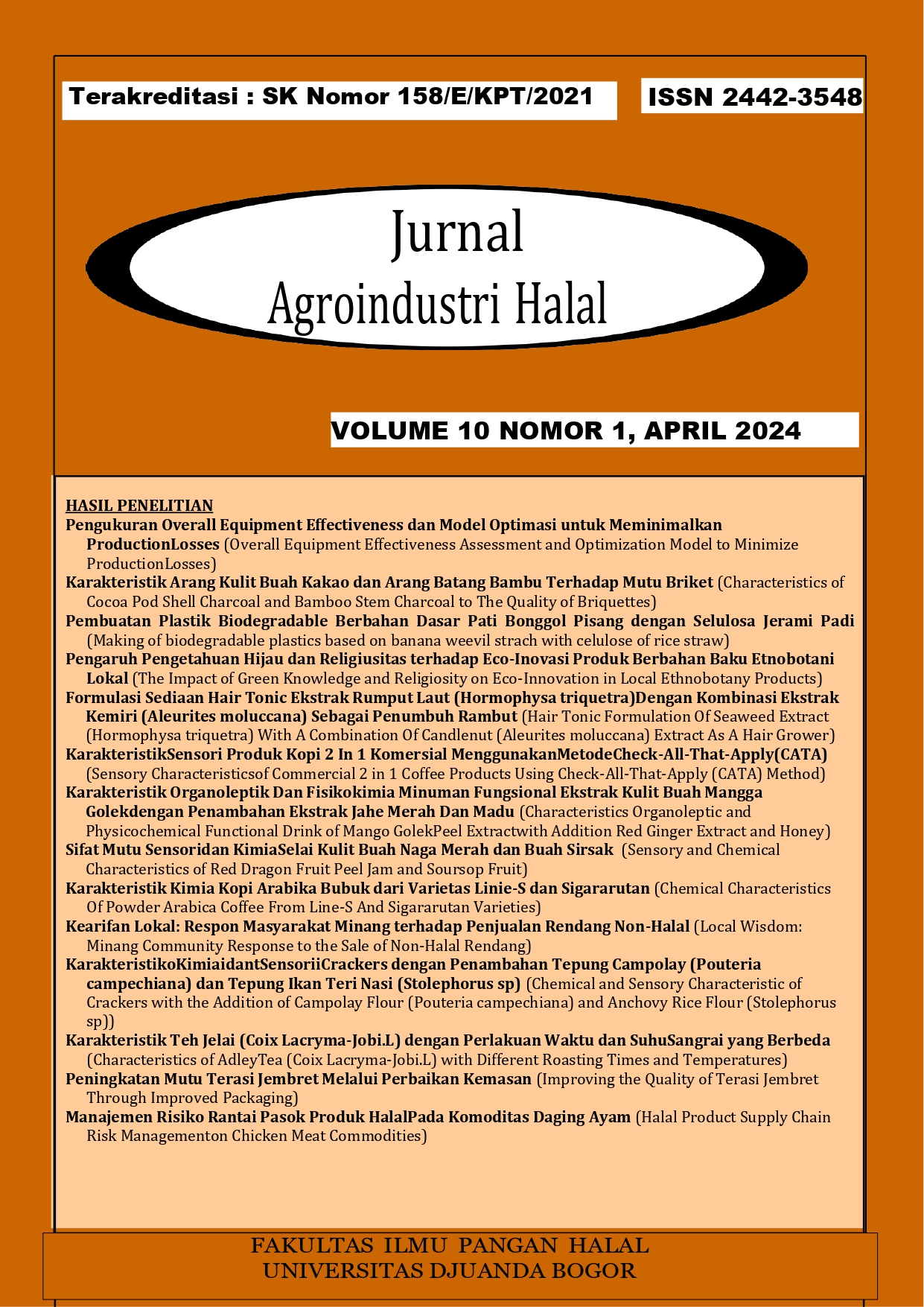Karakteristik Kimia Kopi Arabika Bubuk dari Varietas Linie-S dan Sigararutan
Main Article Content
Abstract
One of eastern Indonesia's top places for producing high-quality coffee, particularly Arabica coffee, is Gowa Regency. Ground coffee's chemical composition is significantly influenced by the post-harvest and coffee harvesting procedures used to produce it. The Indonesian National Standard (SNI) 01-3542-2004 compares a range of values about ground coffee that can be used to evaluate the coffee's quality. This study's goals are to determine which arabica coffee varieties have chemical attributes that are in line with (SNI) 01-3542-2004 and to look into the chemical makeup of ground arabica coffee from the Gowa Regency's linie-S and sigararutan kinds. The Sigararutan and linie-S types of arabica coffee beans, both from the Tinggimoncong District, were utilized in the study. In the research investigation, a non-factorial fully randomized design (CRD) was used in three replications. Chemical analysis examines the composition of coffee extract, moisture, ash, and caffeine. The results showed that powdered arabica coffee of the Linie-S variety differed considerably from powdered arabica coffee of the Sigararutan type in terms of water content, ash content, and caffeine content. The amounts of coffee extract in the two samples, however, were not substantially different from one another. The water, ash, caffeine, and coffee essence contents of the Linie-S and Sigararutan varieties of powdered arabica coffee satisfy the requirements outlined in (SNI) 01-3542-2004 for ground coffee.
Article Details

This work is licensed under a Creative Commons Attribution-ShareAlike 4.0 International License.
Authors who publish with Jurnal Agroindustri Halal agree to the following terms:
- Authors retain copyright and grant the journal right of first publication with the work simultaneously licensed under a Creative Commons Attribution 4.0 International License that allows others to share the work with an acknowledgement of the work's authorship and initial publication in Jurnal Agroindustri Halal.
- Authors are able to enter into separate, additional contractual arrangements for the non-exclusive distribution of the journal's published version of the work (e.g., post it to an institutional repository or publish it in a book), with an acknowledgement of its initial publication in Jurnal Agroindustri Halal.
- Authors are permitted and encouraged to post their work online (e.g., in institutional repositories or on their website) prior to and during the submission process, as it can lead to productive exchanges, as well as earlier and greater citation of published work
References
Babova, O., Occhipinti, A., & Maffei, M. E. (2016). Chemical partitioning and antioxidant capacity of green coffee (Coffea arabica and Coffea canephora) of different geographical origin. Phytochemistry, 123, 33–39. https://doi.org/10.1016/j.phytochem.2016.01.016
Betriana, N., & Oktasari, A. (2022). Penetapan kadar abu dan sari kopi pada berbagai jenis kopi bubuk. Prosiding Seminar Nasional Sains Dan Teknologi Terapa, 5(1920802014), 391–396.
Budiyanto, B., Uker, D., & Izahar, T. (2021). Karakteristik Fisik Kualitas Biji Kopi Dan Kualitas Kopi Bubuk Sintaro 2 Dan Sintaro 3 Dengan Berbagai Tingkat Sangrai. Jurnal Agroindustri, 11(1), 54–71. https://doi.org/10.31186/j.agroindustri.11.1.54-71
Clemente, J. M., Martinez, H. E. P., Alves, L. C., & Lara, M. C. R. (2013). Effect of N and K doses in nutritive solution on growth, production and coffee bean size. Revista Ceres, 60(2), 279–285. https://doi.org/10.1590/S0034-737X2013000200018
Edvan, B. T., Edison, R., & Same, M. (2016). Pengaruh Suhu dan Lama Penyangraian pada Mutu Kopi Robusta (Coffea robusta). Jurnal Agro Industri Perkebunan, 4(1), 31–40.
Estiasih, T., & Ahmadi. (2017). Teknologi Pengolahan Pangan (Cetakan ke). Bumi Aksara.
Fajriana, N. H., Fajriati, I., Kimia, J., Sains, F., Teknologi, D., Islam, U., Sunan, N., & Yogyakarta, K. (2018). Analisis Kadar Kafein Kopi Arabika (Coffea arabica L.) Pada Variasi Temperatur Sangai Secara Spektrofotometri Ultra Violet. Analit: Analytical and Environmental Chemistry, 3(02), 148–162.
Fibrianto, K., & Ramanda, M. P. A. D. (2018). Perbedaan Ukuran Partikel Dan Teknik Penyeduhan Kopi Terhadap Persepsi Multisensoris: Tinjauan Pustaka. Jurnal Pangan Dan Agroindustri, 6(1), 12–16. https://doi.org/10.21776/ub.jpa.2018.006.01.2
Hanifah, N., & Kurniawati, D. (2013). Pengaruh larutan alkali dan yeast pada proses pembuatan kopi fermentasi. Jurnal Teknologi Kimia Dan Industri, 2(2), 162–168.
Hayati, R., Marliah, A., & Rosita, F. (2012). Chemical characteristics and sensory evaluation of arabica coffee powder. J. Floratek, 7, 66–75.
Maskar, R., & Faisal, F. (2022). Analisis Kadar Kafein Kopi Bubuk Arabika di Sulawesi Selatan Menggunakan Spektrofotometri UV-VIS. Gorontalo Agriculture Technology Journal, 5(1), 19. https://doi.org/10.32662/gatj.v5i1.2010
Mubarok, F., Suwasono, S., & Palupi, N. W. (2014). Perubahan Kadar Kafein Biji Kopi Arabika Hasil Pengolahan Semi Basah Dengan Perlakuan Variasi Jenis Wadah Dan Lama Fermentasi. Berkala Imliah Pertanian, x(1), 1–7.
Nugroho, J. W. K., Lumbanbatu, J., & Sri, R. (2009). Pengaruh Suhu dan Lama Penyangraian Terhadap Sifat Fisik-Mekanis Biji Kopi Robusta. Seminar Nasional Dan Gelar Teknologi PERTETA, 2081(7152), 217–225.
Oktadina, F. D., Argo, B. D., & Hermanto, M. B. (2013). Pemanfaatan Nanas (Ananas Comosus L. Merr) untuk Penurunan Kadar Kafein dan Perbaikan Citarasa Kopi (Coffea Sp) dalam Pembuatan Kopi Bubuk. Jurnal Keteknikan Pertanian Tropis Dan Biosistem, 1(3), 265–273.
Pinkan, A., Damayanti, R. P., & Putri, N. A. (2021). KARAKTERISTIK EKSTRAK KAFEIN PADA BEBERAPA VARIETAS KOPI DI INDONESIA: REVIEW. Jurnal Ilmiah Teknologi Dan Industri Pangan, 6(1), 78–89.
Purnamayanti, N. P. A., Ida, B. P., & Gede, A. (2017). Pengaruh Suhu dan Lama Penyangraian Terhadap Karakteristik Fisik dan Mutu Sensori Kopi Arabika (Coffea arabica L). Jurnal BETA (Biosistem Dan Teknik Pertanian, 5(2), 39–48.
Rahardjo. P. (2013). Kopi : Panduan Budi Daya dan Pengolahan Kopi Arabika dan Robusta. Cetakan Ke 2. Penerbitr Swadaya.
Rialita Kesia Maramis, Citraningtyas, G., & Wehantouw, F. W. (2013). ANALISIS KAFEIN DALAM KOPI BUBUK DI KOTA MANADO MENGGUNAKAN SPEKTROFOTOMETRI UV-VIS. Jurnal Ilmiah Farmasi – UNSRAT, 2(4), 122–128.
Sivetz, M., & Desrosier, N. W. (1979). Coffee technology. AVI Publishing Co. Inc., Westport, Conn. https://doi.org/https://doi.org/10.1016/0308-8146(82)90101-7
Suaniti, N. M., Saraswati, A. A. S. D., & Putra, A. A. B. (2022). ANALISIS KAFEIN DALAM KOPI ARABIKA (Coffea arabica L.) PADA BERBAGAI SUHU PENYANGRAIAN DENGAN METODE SPEKTROFOTOMETER UV-VIS DAN GC-MS. Jurnal Kimia, 16(1), 115. https://doi.org/10.24843/jchem.2022.v16.i01.p15
Taib, G., Said, G., & Wiraatmaja, S. (1988). Operasi pengeringan pada pengolahan hasil pertanian (Ed. 1, cet). Mediyatama Sarana Perkasa.
